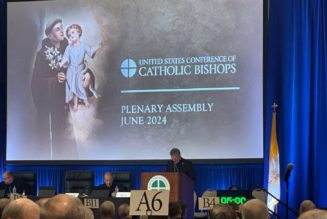“Look, here is water. What is to prevent my being baptized?” So said the Ethiopian Eunuch travelling with Philip (Acts 8:36). In these times of the coronavirus (COVID-19), most dioceses in the United States did not celebrate the sacraments of initiation at the Easter Vigil. Some dioceses are celebrating them at the Extended Form of the Vigil of Pentecost. For others, however, the sacraments of initiation (baptism, confirmation, and the Eucharist) will have to be celebrated in small groups or at least in celebrations of greatly reduced numbers in the weeks ahead. But not to worry: the sacraments of initiation have always taken place at different times of the year, and the Church makes provision for this possibility.
Unusual Circumstances and Pastoral Needs?
If you’ve ever read through a liturgical text and found lines permitting the liturgical exception “for serious pastoral needs,” you’ve probably had to consider if your circumstances qualify. Not so today—at least as far as the sacraments of initiation are concerned! The Rite of Christian Initiation of Adults (RCIA) makes provision for celebrating the sacraments of initiation apart from the Easter Vigil. Indeed, because “of unusual circumstances and pastoral needs…, the sacraments of initiation may be celebrated at a time other than the Easter Vigil or Easter Sunday” (26). Paragraphs 26-30 of the RCIA highlight items to consider for the “Celebration of the Sacraments of Initiation Outside the Usual Times.”
What Time?
If you’re celebrating outside the usual time, what time should be chosen? Naturally, a Sunday “during the Easter season” would be best (see RCIA, Introduction, 27), but most other Sundays are especially apt since Sunday is the weekly memorial of “the day when Christ conquered death and gave us a share in his immortal life” (Dies Domini, 44). However, given the circumstances, a weekday may be necessary in 2020. That said, “care should be taken to ensure that” whatever day is chosen for celebrating the sacraments of initiation, it should have “a markedly paschal character” (RCIA 208; RCIA, General Introduction, 6).
Which Prayers?
Depending on the liturgical calendar, the Mass texts chosen for the occasion should be from “one of the ritual Masses ‘Christian Initiation: Baptism’ given in the Roman Missal,” A or B (RCIA, 208). The ritual Masses may be used on any day except “Sundays of Advent, Lent, and Easter, on solemnities, on the days within the Octave of Easter, on the Commemoration of All the Faithful Departed (All Souls’ Day), on Ash Wednesday, and during Holy Week” (GIRM, 372). If the sacraments of initiation are celebrated on one of these more solemn days, the Mass of the day is used, with readings and orations proper to that day. If the Ritual Mass, “For the Conferral of Baptism,” is used, white vestments are worn (see GIRM, 347). If the celebration of the Sacraments of Initiation takes place during a Mass in which the Mass of the day is used (see above), the color proper to that day is used.
Regardless of the day of the celebration, the Gloria is included (see GIRM, 126). The Creed is always omitted, having been replaced by the renewal of baptismal promises. If the Ritual Mass is used, the Penitential act is also omitted (See Roman Missal: Ritual Masses, For the Conferral of Baptism). See RCIA 206-243 for a theological introduction and an order of Celebrating the Sacraments of Initiation within Mass.
Which Readings?
If the initiation sacraments are celebrated on a Solemnity, the readings of the day are used (per GIRM, 372, above). If celebrated on another day, the readings “are chosen from those given in the Lectionary for Mass, ‘Celebration of the Sacraments of Initiation apart from the Easter Vigil’” (RCIA 208), found at numbers 751-755 in the Lectionary (Volume IV). Three readings should be chosen for this Ritual Mass. Outside of the Easter Season, the first reading should come from the options given in the Old Testament; during the Easter Season, the first reading may be chosen from the Acts of the Apostles from the options given in the selection of New Testament readings (see number 752, options 1-2).
Which Rites?
Elect to be Baptized
An option is chosen for the presentation of the candidates (see RCIA 219, A, B, or C). Unless the baptismal font is located in the sanctuary, there is a procession to the font, led by the minister bearing the Easter candle, as the Litany of the Saints is chanted (RCIA 221 or the translation in the Roman Missal: Easter Vigil, 43). At the font, the celebrant blesses the water using form A, B, or C (RCIA 222 or the translation in Roman Missal: Easter Vigil, 44).
During the blessing of water, the Easter candle is not placed in the baptismal water outside the Easter Vigil; rather, the celebrant “touches the water with his right hand” (RCIA, 222 A, B). If water was already blessed at the Easter Vigil and is employed for use in the baptisms, the thanksgiving (Form D or Form E) is said in lieu of the blessing of the water.
After the Renunciation of Sin, the celebrant then leads the candidates in the questions of the Profession of Faith (RCIA 224-5 or the translation contained in the Roman Missal: Easter Vigil 55).
While the clothing of the neophytes with a white garment is optional (RCIA, 229), the presentation of the lighted candle is not optional (RCIA, 230). If there are no candidates for full communion, the Celebration of Confirmation follows immediately at the font or in the sanctuary, depending on the place where baptism has been celebrated (RCIA, 231).
Note that an instrument, for example a cotton ball, may not be used for conferring the Sacrament of Confirmation. While the law itself makes provision for the use of an instrument in the Anointing of the Sick (Canon 1000 §2), the same cannot be said regarding Confirmation. The Code of Canon Law (Canon 880) and the 1971 Apostolic Constitution Divinae consortium naturae by Pope St. Paul VI require that the anointing be accompanied by the imposition of the hand. Consequently, the right thumb of the minister must be applied to the candidate for validity (see The Order of Confirmation, 27).
If there are no candidates for full communion, there is no renewal of baptismal promises or sprinkling of the assembly at this point (RCIA, 236), and the Creed is not said (RCIA, 241). After being confirmed, the neophytes are led to their places, and Mass continues with the prayers of the faithful in the usual way (RCIA, 236, 241).
The translation of the Order of Confirmation, promulgated in 2016, may be used in place of the translation in the RCIA book at numbers 233-4. Accordingly, the address of the priest to the people before the laying on of hands is employed as he recites the following set of prayers:
Dearly beloved,
let us pray to God the almighty Father,
for these, his adopted sons and daughters,
already born again to eternal life in Baptism,
that he will graciously pour out the Holy Spirit upon them
to confirm them with his abundant gifts,
and through his anointing
conform them more fully to Christ, the Son of God.
The prayer at the Laying on of Hands:
Almighty God, Father of our Lord Jesus Christ,
who brought these your servants to new birth
by water and the Holy Spirit,
freeing them from sin:
send upon them, O Lord, the Holy Spirit, the Paraclete;
give them the spirit of wisdom and understanding,
the spirit of counsel and fortitude,
the spirit of knowledge and piety;
fill them with the spirit of the fear of the Lord.
Through Christ our Lord.
Amen.
Along with Candidates for Full Communion:
If both catechumens and candidates are included in the Vigil of Pentecost, a combined rite is used (RCIA, 562-594). After the baptism of the elect (either at the font or in the sanctuary), the candidates for full communion and all those present with them are asked to renew their baptismal promises (RCIA, 580-582). While it would seem appropriate that the sprinkling rite follow this (RCIA, 583), this seems odd outside the Easter Vigil. Nevertheless, there is no other document that governs a combined rite. After processing to the sanctuary, the candidates for full communion add their individual profession of the Catholic faith: “I believe and profess all that the holy Catholic Church believes, teaches, and proclaims to be revealed by God” (RCIA, 584–586), and the confirmation of both the newly baptized and the newly received takes place at the same time.
Conclusion
The “joy of the Gospel” flows forth from “hearts and lives of all who encounter Jesus” (Evangelii Gaudium 1), but especially with those who experience for the first time the “sacramental sharing in Christ’s dying and rising” (RCIA, 8). While celebrating the sacraments of initiation outside the usual time is not ideal, we know that no time is outside the unfolding and enfolding glory of the Paschal Mystery. The prayers of the Roman Missal and the texts of the RCIA show forth the paschal glory as the “fullness of time” is again renewed and manifested in our “adoption as sons” (Galatians 4:4). No one initiated into the Paschal Mystery in 2020 will forget it…if only for being outside the usual time. Nevertheless, even outside the Easter Vigil, the deepest reality that impresses upon us is the knowledge that “all time belongs to him…, and all the ages…. To him be glory and power through every age and forever” (Roman Missal: Easter Vigil blessing of the Paschal Candle, 11).








